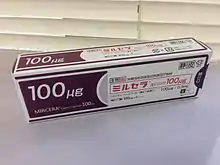Methoxy polyethylene glycol-epoetin beta
| Clinical data | |
|---|---|
| Drug class | Erythropoiesis-stimulating agent (ESA)[1] |
| Main uses | Low red blood cells due to chronic kidney disease[1] |
| Side effects | High blood pressure, diarrhea[2][1] |
| External links | |
| AHFS/Drugs.com | Monograph |
| Legal | |
| License data | |
| Legal status |
|
Methoxy polyethylene glycol-epoetin beta, sold under the brand name Mircera, is a medication used to treat low red blood cells due to chronic kidney disease.[1] It is given by injection.[2] Hemoglobin levels should not be increased above 110 g/L (11 g/dL).[1]
Common side effects include high blood pressure and diarrhea.[2][1] Other side effects may include erythema multiforme, anaphylaxis, seizures, and worsened outcomes in people with cancer.[1] It is an erythropoiesis-stimulating agent (ESA) and works the same as erythropoietin.[1][2]
Methoxy polyethylene glycol-epoetin beta was approved for medical use in the United States and Europe in 2007.[1][2] It is on the World Health Organization's List of Essential Medicines.[3] In the United Kingdom 75 micrograms costs the NHS about £110 as of 2021.[4] This amount in the United States is about 220 USD.[5]
Medical uses
Dosage
It is started at a dose of 600 to 1200 nanograms/kg every two weeks (42 to 84 micrograms for a 70 kg person).[4]
It is supplied as a solution in pre-filled syringes for intravenous or subcutaneous administration.
Chemistry
Methoxy polyethylene glycol-epoetin beta is made from erythropoietin by chemically linking the N-terminal amino group or the ε-amino group of any lysine present in the protein with methoxy polyethylene glycol butanoic acid. The average molecular weight is approximately 60 kDa.[6] The drug stimulates erythropoiesis by interacting with the erythropoietin receptor on progenitor cells in the bone marrow.[6] It has a reduced receptor binding activity compared to other ESAs and but retains in vivo activity due to an extended serum half-life. It has an in vivo half-life of around 135 hours (5.6 days) as compared to darbepoetin alfa which has a half life of around 21 to 70 hours, the half life of which is three times that of the naturally occurring erthropoietin in the body.
History
It is the first approved, chemically modified erythropoiesis-stimulating agent (ESA).
Society and culture
Patent infringement

A U.S. Federal Appeals Court ruled 15 September 2009 that Mircera infringes a patent held by Amgen Inc. The court refused to lift an injunction entered in the fall of 2008 which barred Roche from selling Mircera in the United States.[7] However, the injunction has since expired and Mircera is available on the US market since 2015.[8]
Sports
Mircera can reportedly replace traditional EPO drugs as blood doping agent in endurance sports. The drug appears to fall under section S2 of the list of substances officially prohibited - in competition and out of competition - in France and by the World Anti-Doping Agency.[9]
On July 17, 2008, Italian bicycle racer Riccardo Riccò was disqualified from the Tour de France after reports that a urine sample tested positive for Mircera.[10][11] There had not previously been any public acknowledgment that a test for the new drug was being administered, or had even been developed yet. The Tour de France testing was done under the auspices of the French Cycling Federation and the French Anti-Doping Agency, not the Union Cycliste Internationale.[12][13]
References
- 1 2 3 4 5 6 7 8 9 "Methoxy Polyethylene Glycol-epoetin Beta Monograph for Professionals". Drugs.com. Retrieved 17 November 2021.
- 1 2 3 4 5 "Mircera". Archived from the original on 29 December 2019. Retrieved 17 November 2021.
- ↑ World Health Organization (2021). World Health Organization model list of essential medicines: 22nd list (2021). Geneva: World Health Organization. hdl:10665/345533. WHO/MHP/HPS/EML/2021.02.
- 1 2 BNF 81: March-September 2021. BMJ Group and the Pharmaceutical Press. 2021. p. 1064. ISBN 978-0857114105.
- ↑ "Mircera Prices and Mircera Coupons - GoodRx". GoodRx. Retrieved 17 November 2021.
- 1 2 Macdougall IC, Eckardt KU (September 2006). "Novel strategies for stimulating erythropoiesis and potential new treatments for anaemia". Lancet. 368 (9539): 947–53. doi:10.1016/S0140-6736(06)69120-4. PMID 16962885. S2CID 43889549.
- ↑ Kendall B (15 September 2009). "Update: US Court Won't Disturb Injunction Against Roche Anemia Drug". Dow Jones Newswires Tuesday.
- ↑ "FMC aims for 110,000 U.S. patients to be on Mircera in first-quarter". Reuters. 24 April 2017. Archived from the original on 5 September 2016. Retrieved 23 May 2017.
- ↑ "Substances et méthodes interdites en permanence (en et hors compétition)" (PDF) (in French). Archived from the original (PDF) on 12 November 2008.
{{cite web}}: CS1 maint: unrecognized language (link) (Décret no 2008-35 du 10 janvier 2008 portant publication de l’amendement à l’annexe de la convention contre le dopage, adopté par le groupe de suivi lors de sa 26e réunion le 12 novembre 2007 à Madrid.) - ↑ Pelkey C (17 July 2008). "Riccardo Riccò tests positive; Saunier Duval team withdraws from Tour de France". VeloNews. Archived from the original on 5 August 2009.
- ↑ Wyatt E (18 July 2008). "Tour de France team out after test". The New York Times. Archived from the original on 31 October 2021. Retrieved 4 October 2021.
- ↑ "The 2008 Tour de France under the control of the French Cycling Federation". Amaury Sport Organisation. 6 March 2008. Archived from the original on 16 March 2008. Retrieved 17 July 2008.
- ↑ "L'Agence française de lutte contre le dopage" (in French). Archived from the original on 12 October 2007. Retrieved 17 July 2008.
{{cite web}}: CS1 maint: unrecognized language (link)
External links
| Identifiers: |
|---|